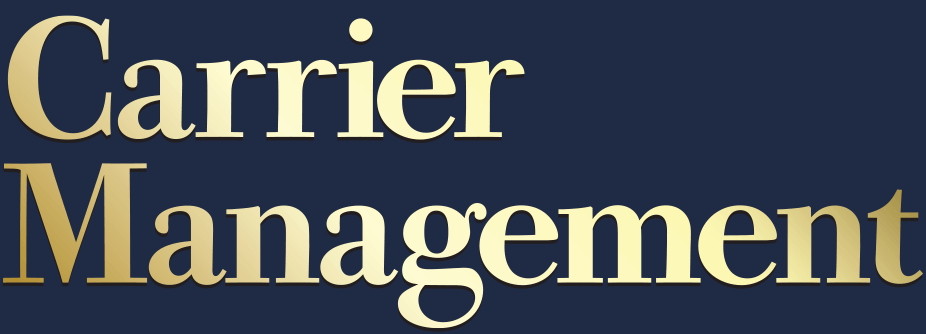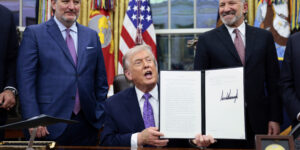While the U.S. property/casualty combined ratio sat at the lowest level in five years during 2024, the industry’s key metric is headed up to the 98-100 range for 2025, analysts from S&P Global Ratings predict.
During a webinar in late March, the rating agency provided earnings updates for the U.S. P/C and global reinsurance sectors, and discussed the stable credit rating outlooks for both, which are supported by robust capital levels.
The webinar took place before President Trump’s April 2 announcement of multiple tariffs on dozens of countries and subsequent pauses, prompting the rating agency to publish a series of reports assessing the capital strength of insurers and reinsurers under stressed equity market scenarios last week. (See “Trade Wars Begin” section below)
During the webinar, Saurabh Khasnis, director and lead analyst P/C insurance, gave the early forecast of full-year 2025 combined ratios, blaming shrinking loss reserve cushions and the impact of catastrophe losses—notably the January wildfires in California—for the likely deterioration ahead.
“We believe catastrophe losses will remain elevated and they will contribute nearly 10 to 12 points to the combined ratio. And we expect reserve adjustments will have a negligible impact on the underwriting margins,” he said, after displaying a slide showing combined ratios for the last five years.
From 2020-2023, U.S. P/C insurance industry combined ratios hovered between 98.8 (for 2020) and 102.7 (for 2022). A personal lines turnaround and continued solid performance in commercial lines drove the 2024 aggregate combined ratio down to 96.6—more than 5 points below a 101.8 for 2023.
That improved result came in spite of higher cat losses in 2024, which added 12.6 points to the industry combined ratio, compared to 9.7 points in 2023. And favorable reserve development shaved only 0.3 points off the 2024 combined ratio—about the same as 2023 (0.2 points) but less than the roughly 1.0 point benefits shown for the earlier years on the slide—in 2020 and 2021.
The ex-cat accident year loss ratio (excluding the impact of reserve changes) “improved by nearly 8 points resulting from rate increases and disciplined underwriting,” Khasnis said, explaining the stellar overall combined ratio in 2024.
Offering forecasts on the continued high catastrophe loss impacts and low levels of downward reserve adjustments, Khasnis contrasted the elevated catastrophe losses for last five years with the previous five. Between 2015 to 2019, catastrophe losses contributed about 6.8 percentage points to the combined ratio on average, he said. In the more recent five-year period from 2020 to 2024 that number has now jumped to 12 percentage points. “This nearly doubling of catastrophe loss impact isn’t just due to the named perils like hurricanes. It is also driven by a massive increase in losses from severe convective storms,” he said.
Khasnis said S&P estimates that the January 2025 wildfires will consume 30 percent of carriers’ catastrophe budgets for the year, on average, based on the publicly announced loss estimates collected so far. “This is pretty significant, especially considering it’s happening so early in the year.”
“Additionally we expect the LA wildfire losses could contribute, on average, nearly seven to 10 percentage points to these insurers first-quarter 2025 combined ratios as well,” he said.
The wildfire losses, combined with the prospect of catastrophe levels coming in similar to last year for the remainder of the year, will put full-year 2025 earnings “under pressure” for some insurers with geographic concentrations, he said.
Later, Taoufik Gharib, director and lead analyst for reinsurance ratings at S&P Global Ratings, said the rating agency estimates that roughly 20 percent of the industry LA wildfire losses will be borne by global reinsurers—and those losses, S&P estimates, will consume 35-40 percent of full-year cat budgets for the reinsurers. “It will leave less buffer for the remainder of the year,” he said.
As is the case for the U.S. primary P/C insurance sector, S&P predicts higher overall combined ratios for global reinsurers in 2025 than in 2024—forecasting the sector average will land in the 92-96 range. By comparison, Gharib presented the five-year history of aggregate combined ratios of a group of Bermuda hybrids as a proxy for the global insurance market, showing lows of 86.7 and 91.6 for 2023 and 2024, down from a 103 in 2020. He also displayed 2024 combined ratios for 10 selected hybrids ranging from sub-85 levels for Arch and RenRe up to a 102.3 for Everest.
Adverse Reserve Development: It’s Not Over
A $1.7 billion reserve charge for Everest’s casualty insurance book prompted the only rating action that S&P has taken this year for a company included in the global reinsurance segment—an outlook change to negative to stable, Gharib said. And both Gharib and Khasnis highlighted reserve issues among those on their radar that will likely contribute to worsening underwriting results in 2025.
Although both analysts said the sectors they analyze remain on stable outlooks, Gharib pointed to loss reserve adequacy concerns as the reason for not bumping the outlook for the better-performing reinsurance sector up to positive from stable.
The fact that 26 percent of reinsurers’ ratings have positive outlooks, compared to just 12 percent for U.S. primary P/C companies, prompted Moderator Carmi Margalit, managing director and life insurance sector lead, to ask about a potential switch to positive outlook for the reinsurance sector overall.
“We have been debating [that] internally for the past 12 to 18 months,” Gharib said, acknowledging more positive outlooks than negative for rated reinsurers. The reinsurance industry is performing well and earned its cost of capital in 2023, 2024—and S&P expects that to continue in 2025. But “one of the key risks preventing” the favorable outlook change is adverse reserve development in certain U.S. casualty lines. “We’ve seen some of the major players getting hit with those. We don’t think it’s over,” Gharib said.
Khasnis noted that the U.S. P/C insurance segment is still benefiting from favorable prior year reserve developments but that the benefits are diminishing “and now contribute very little to the underwriting results.”
“When we look closer at the reserve adequacy across different lines of business, we see some broader trends that have taken hold, for example in areas like general liability, excess liability or umbrella policies as well as in commercial auto,” he said, referring to the impacts of social inflation, large jury awards and increased attorney representation. “These trends are not just limited to the soft pricing years of 2015 to 2019. We are seeing these trends across all accident years including the recent ones,” he said.
Trade Wars Begin
In describing the respective segments of the industry for which they lead analysis teams, both men cited “robust capital positions” as industry tailwinds that support S&P’s stable outlooks, noting that capital could cushion impacts from increased catastrophe losses and other stresses.
But that was before investment markets began to swing in the wake of tariffs announced by the Trump administration in early April.
“S&P Global Ratings believes there is a high degree of unpredictability around policy implementation by the U.S. administration and responses—specifically with regard to tariffs—and the potential effect on economies, supply chains, and credit conditions around the world. As a result, our baseline forecasts carry a significant amount of uncertainty,” S&P wrote in the introductions to follow-up reports on capital strength. (“Robust Capital Supports North American Insurers Amid Market Volatility,” published April 9; Global Reinsurers Stand Strong Amid Investment Volatility and Natural Disasters,” published April 10; North American Property and Casualty Insurers Show Strength Under Dual Capital Pressure,” published April 11)
In a report on North American P/C insurers, S&P performed a two-factor capital stress test which considers a decline of 35 percent in the equity valuations and a jump in catastrophe losses (doubling the cat load), finding that total available capital would drop about 22 percent under the test, which S&P describes as one of moderate rather than extreme stress.
In addition, the test results show that roughly one-quarter of U.S. rated primary insurers could experience capital pressure in 2025.
Related article: AM Best: Tariff Uncertainty Could Lead to Credit Rating Changes for Insurers
Still, S&P concluded that in spite of evidence of potential vulnerabilities to the overall capital, “we believe the aggregate capital remains resilient.”
Sharing the technical details of the test, the April 11 S&P report said that capital redundancy at a 99.95 percent confidence level stood at 18.9 percent pre-test, dropping to a deficiency of 6.6 percent after the stress test.
S&P believes that stable operating margins, disciplined exposure management, and conservative asset allocation approaches will allow insurers to recover from “this modest reduction” in capital headroom.
Updating the webinar information on catastrophe losses, the S&P report said that severe storms in March added to totals, with more than half of U.S. primary insurers’ annual cat budgets now likely depleted in the first quarter alone. On top of that, uncertainty about the global trade war played out in investment markets with the S&P 500 Index dropping 15 percent for the year-to-date ending April 7, 2025, followed by a 9.5 percent rebound on April 9, the report says.
In a separate report on the impact of capital stresses to the top 19 reinsurers—including various levels of equity declines, increased cat losses, and a 20 percent boost in loss reserves—S&P found that the capital level would remain redundant at the 99.95 percent confidence level, only becoming deficient at the 99.99 percent confidence level. (Here, stresses were assessed separately rather than in combination).
Hypothetical equity portfolio declines of 15 percent, 25 percent, and 35 percent would produce $4.7 billion, $7.8 billion, and $11.0 billion capital hits from unrealized investment losses, S&P estimated, compared to a capital buffer of at least $21.5 billion (at the 99.99 percentile capital adequacy level based on 2023 financials and surveys, with year-end 2024 expected to be similar).
S&P noted the generally stable nature of reinsurers’ investment strategies—with the reinsurance sector’s largest allocation in high-quality, fixed income securities—and the fact that the hypothetical stress scenarios exclude potential earnings contributions or management actions, such as suspending share buybacks, which could further reinforce the sector’s resilience.
Recession Scenario
During the late-March webinar, Margalit noted that the possibly of a recession has been growing, according to S&P economists, who put the chances of an outright recession within the next 12 months at 25 percent at that point.
While none of the April S&P reports addressed the impacts of recession on the P/C sector, a report published by AM Best on April 15 noted that a downturn that causes reduced levels of economic activity and stymies international trade could lower the demand for P/C insurance. Decreased revenue for impacted industries would translate to a lower exposure base used to determine premiums, the report said. (Read more about the AM Best report in the article, “AM Best: Tariff Uncertainty Could Lead to Credit Rating Changes for Insurers.”)
In a separate report, published on April 10, analysts from Morgan Stanley compared the performance of P/C insurer and broker stocks to the S&P 500 over seven historical recession periods dating back to 1980. The Morgan Stanley analysts found that P/C insurers outperformed the S&P 500 in four of the seven periods and brokers outperformed in five. One notable recession period when P/C insurers underperformed was the earliest, the 1980 recession which was driven by inflation that resulted in interest rate increases.
The Morgan Stanley report also analyzed premium growth in bull and bear markets, reporting that commercial lines insurers grew their top lines more than personal lines insurers during bear markets. A notable exception was the 2008 bear market when personal lines stayed relatively flat and commercial insurers shrank their insurance businesses, according to a chart in the report.
Recession or no, Morgan Stanley analysts believe P/C insurers will continue to grow in 2025, with elevated weather catastrophes, social inflation fears and conservative investment portfolios continuing to support their growth.
Still, personal lines premium growth rates may decelerate vs. 2024, the Morgan Stanley report says, noting that the personal lines market is entering a more competitive phase. Tariffs could temper the pace of competition, however, the report notes.
AM Best suggested that tariff impacts could spur premium increases for personal auto insurers, in particular. “[W]e may be entering a scenario of déjà vu because of the tariffs,” AM Best wrote in a report published a day before mainstream media outlets started to report that President Trump might consider pausing auto and parts tariffs. “If spare vehicle parts become more expensive due to tariffs and add on inflationary pressure, claim costs would be expected to risk, resulting in rate adequacy concerns, which will become a prominent focus again for personal auto carriers.”
Related articles: Insurance Industry Contemplates Knock-On Effect of Tariffs to Claims, Consumers; Progressive’s Margins Leave Room for Tariff Impacts; Others Ready Too





















 Odometer Fraud Sees 14% Jump in the Past Year
Odometer Fraud Sees 14% Jump in the Past Year  The Hardest Part of Innovation in Insurance Isn’t Technology; It’s Culture
The Hardest Part of Innovation in Insurance Isn’t Technology; It’s Culture  Why Insurance Telematics Integrations Fail
Why Insurance Telematics Integrations Fail  Insurance Industry ‘Megadeals’ Dominate 2025, Says PwC
Insurance Industry ‘Megadeals’ Dominate 2025, Says PwC 
